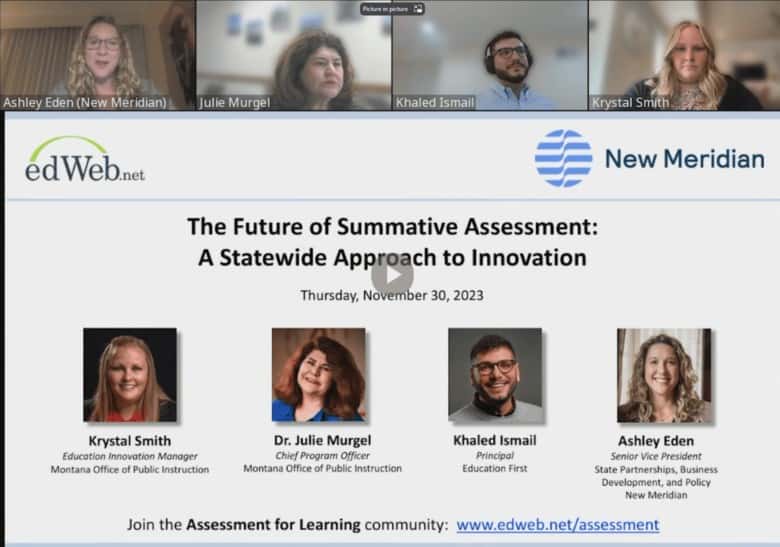Editor’s Note: This is the first installment of The Prime’s Decoding the Data series, which examines organizations that package and present assessment data in new and creative ways. See the entire series on New Meridian’s website.
Fourteen hours after her day began, Camila finally has a moment to herself. She cherishes the 9 p.m. hour, a precious window of time that allows her to clean, pay bills and catch up after her kids go to bed.
Tonight, one item on the catch-up list is watching a video she recently received in an email; the video describes her daughter Maria’s results on California’s statewide assessment. It depicts four animated children ascending a hill on bicycles, including her daughter Maria. She is pedaling at the center of the pack, with the test score 2457 above her. The two children behind her are marked “Mt. Diablo Unified 2432” and “California 2422.” One in front is labeled “Sequoia Avenue Elementary 2477.”
The video is one of about a quarter-million produced annually by Spotlight, a startup that is working with ETS, the state’s summative test provider, to help parents better understand results of the annual California Assessment of Student Performance and Progress (CAASPP). It shows Camila instantly how her daughter’s performance tracks against the school, the district, and the state, and goes on to explain the challenges she faces and how she can improve.
Spotlight is part of a new wave of pioneering organizations that translate vast amounts of complex assessment data into information that can be easily understood by parents, teachers, educators and policy makers. Their efforts are turning this data from academic autopsies into actionable information that can be used to guide improvements throughout the education system.
Giving Parents Better Data
In recent years, there’s been a dramatic rise in the number of schools using assessment data to make decisions about instruction and intervention. Last year, 75 percent of teachers identified data-informed instruction as the top trend in education, according to a survey conducted by Kahoot! That’s more than double the percent who identified it as a top trend a year earlier.
But if assessment-generated data has quickly emerged as an invaluable aid for educators, the benefits to parents have come at a much slower pace.
“Historically, the assessment results sent to parents have not been created with parents in mind as the end user. In order for the value proposition of high-quality tests to be fully realized, we must see the parents as a primary stakeholder and design the accompanying reports accordingly,” said Bibb Hubbard, founder and president of Learning Heroes, a non-profit focused on helping parents play an active role in their children’s educational success. “So far, parents haven’t been at the center of the equation.”
Hubbard founded Learning Heroes four years ago, motivated by a desire to provide parents with a greater voice in shaping education policy and practices. Empowering parents to become effective change agents, she says, begins with ensuring they have accurate information.
After observing for years a troubling schism between the perception parents have of their children’s academic proficiency and the reality as measured by high-quality assessments, Hubbard’s group commissioned research into the apparent disconnect. What it revealed was astounding: 90 percent of K-8 parents believe their child is functioning at or above grade level in reading and math, but according to the National Assessment of Educational Progress (NAEP)—a test broadly considered the gold standard among academic assessments—only about one-third of students are performing at grade level.
Those sobering initial findings became an impetus to uncover why the glaring disconnect exists.
Empowered to Advocate
Hubbard found that parents tend to put most of their faith in report cards as the key measure of student achievement; on the other hand, most teachers (nearly two-thirds) believe parents put far too much emphasis on report card grades alone.
“Our theory is that if every parent has an accurate picture of their child’s academic performance, they will be empowered to more effectively advocate on behalf of their child, and that in turn will make schools more responsive,” Hubbard said.
Hubbard’s organization may not yet be a recognizable brand name, but it has quietly emerged as an important behind-the-scenes resource among educators, providing fresh market research into the psychology of parents vis-à-vis learning. That research, coupled with the hands-on guidance Learning Heroes provides, is helping states, districts, schools and teachers package and present student data to parents in a way that is not only more user-friendly, but also more actionable.
Such was the case with Spotlight’s videos. In our California example, the animation helps Camila see instantly that her daughter’s score exceeds the district and state averages but is slightly behind the average in her school. Importantly, it explains where her daughter is facing challenges.
“You can see that Maria is a little farther up the hill than the average student in her district, [and] on about the same place on the hill as the average student at her school,” the video intones. “It looks like she has a steep section in her way, that’s an area where she is experiencing a challenge relative to the other areas. Her steep section is problem solving and modeling … here is a sample problem solving and modeling question for her grade. If she can get past this steep section, she should see her grade improve.”
Hubbard and other advocates say that making assessment data easily understood and actionable in ways like this can have a major impact. “When parents are presented with this data, they generally receive it well,” she said. “Fundamentally, parents are problem solvers.”
Next Month: How Washington D.C. public schools used data analytics to determine which actions had the largest impact on student success.


